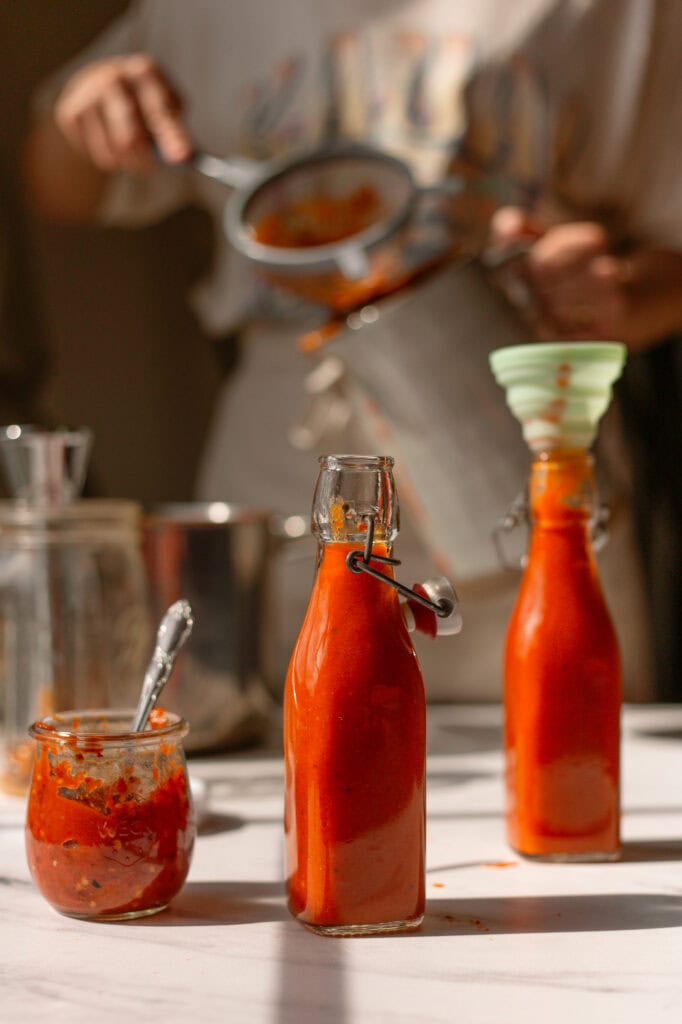The pH of Fermented Foods is Variable
Let’s focus on the pH of fermented vegetables for this blog post. The pH of fermented vegetables should be at or below 4. Many people will throw around the number 4.6, but that is for low-acid canned food, not fermented foods.
Almost always, when lacto-fermenting foods like pickles and sauerkraut, the final pH will be at or below 4.
The potential of lactic acid fermentation to control the harmful effects of food contamination depends on multiple, controllable variables. Have you ever learned about variables in simple science experiments? Let’s review:
- An independent variable is a variable that is changed or controlled in a scientific experiment to test its effects on the dependent variable.
- A dependent variable is a variable being tested and measured in an experiment.

Controlling the pH of Fermented Foods
In a vegetable fermentation experiment, we have something that resembles a dependent variable: The final microbial composition and pH of fermented foods.
There are SIX main factors here that we can consider as independent variables. As these independent variables change, the dependent variable (the microbial composition and pH) will change.
- Substrate: What vegetable is being used? What’s the available sugar content? What’s the vegetable’s microbiome composition? What other ingredients are included? Are there any protein-rich animal-based ingredients in the recipe? These substrate variations can influence which microbes grow and which nutrients are available for microbes to metabolize into other compounds.
- Salt Concentration: The salt concentration determines which groups of microorganisms thrive first in fermented vegetables, thus influencing pH, oxygen levels, and which microbes can thrive after fermentation.
- Fermentation Time: Bacterial succession and microbial metabolism in fermentation take time. How long fermentation occurs impacts if GABA, melatonin, Phenolic compounds, exopolysaccharides, and beneficial bioactive peptides are produced or not.
- Temperature: Too low temperatures can inhibit vegetable fermentation, too high temperatures can ruin the flavor and texture. In some cultures, traditional fermentation recipes include sugar and are fermented at ambient temperatures ranging from 80-90° F, making fermentation quite fast.
- Oxygen: Certain microbes love oxygen, certain microbes love anaerobic environments. Oxygen levels directly influence which microbes thrive. Everything has to stay submerged in the liquid while fermenting or in an air-tight container like a fermentation crock.
- Initial Acidity: Some microbes love acid, and some die in acid. The initial pH and a progressive drop in pH of fermented vegetable influences which microorganisms grow and how acidic the final pH is.

Six Ways to Keep the pH of Fermented Foods in Check
Food safety in fermentation means controlling these independent variables to ensure the best microbial composition, thus, the best microbial byproducts produced and pH.
Therefore, many things can happen when we do not control the variables.
1. Substrate
Just like eating many different vegetables influences the composition of your microbiome, fermenting different vegetables changes the structure of the microbial fermentation community.
Vegetables & fruits with ample sugars, for instance, can encourage yeasts to thrive, leading to excess alcohol production and possible acid metabolism by yeats. Sometimes this can negate the preservative effects of pH decrease.
Including animal products in fermentation, like whey and fish paste, can lead to microbial-produced biogenic amines. This can cause histamine reactions for some people when consumed.
I stick to vegan fermented vegetables only, and if I use fruit in fermented vegetables, the fruit does not make up more than 1/4 of the ingredients.
2. Total Salt Concentration
Not using the proper salt concentration is a major cause of concern. Salt concentration controls initial microbial growth before lactic acid bacteria can produce acid to preserve the vegetables.
Salt roots for Leuconostoc bacteria to start thriving while discouraging yeasts, fungi, and potential pathogens from thriving. This leads to a quick and safe drop in pH.
An adequate salt concentration is vital and extremely effective in controlling dangerous fungi, gram-negative bacteria, and the toxins they can produce in fermentation.
This is because specific salt concentrations encourage the growth of desirable, beneficial microorganisms that rapidly and steadily decrease the pH and preserve the vegetables. These species include Leuconostoc spp. and Lactobacillus spp.
You can reference The Complete Guide to Safely Using Salt in Vegetable Fermentation if you’re looking for guidance on calculating and measuring salt concentrations.
3. Time
Too short of a fermentation time robs you of many beneficial postbiotic compounds. When given enough time, Lactobacillus spp. produce bioactive peptides and polyphenols that are wonderful for health.
Lactobacillus only start to thrive, metabolize, and produce their byproducts after about 7-14 days of fermentation. So, being patient with fermentation projects is the way to go. Anything after seven days is probably okay to taste test, but I like my ferments right around 21-28 days for maximum health benefits and flavor.
Fermenting vegetables for a proper amount of time also influences biogenic amine (histamine) content. If Lactobacillus spp. are given enough time to thrive and then metabolize, a lot of these species have the ability to degrade and decrease biogenic amines in all types of fermented foods.
4. Temperature
Putting your fermentation projects in the fridge too early can lead to low acid production and not enough acid for proper preservation.
On the other hand, fermenting at too high a temperature can cause spoilage microorganisms to thrive in excess in the first five days of fermentation, resulting in unpleasant flavors and poor sensory qualities.
The ideal temperature for vegetable fermentation is between 60 and 90° F (absolute maximum). I like my fermentation temperature right at about 78 degrees F.
5. Oxygen
Fungi will find a way to grow if all ingredients are not submerged in the liquid during fermentation. Fungi do undesirable things in vegetable fermentation. Some fungi produce toxins, and some can metabolize acids, increasing the pH and negating the preservation effects of lactic acid fermentation.
You can learn more about keeping fermented vegetables anaerobic here: How to Keep Fermented Foods Anaerobic
6. Initial Acidity
The initial pH of fermented vegetables influences which microorganisms grow. Generally, an initial pH around 6 is a good place to start. Then, a steady decrease to more acidic conditions is vital. An anaerobic environment may not form if the fermented vegetables start too acidic. Using pH strips is a great way to monitor the changes in pH throughout fermentation.
You do not need to fear fermentation because setting up the right microbes for fermentation success is easy.

Maintaining the pH of Fermented Foods is Easy
What if I told you that all you have to do is weigh your ingredients and keep everything submerged in the brine? That’s it.
All you need is:
- a $5-$15 food scale
- a glass jar
- a rust free plastic lid
- a fermentation weight
- salt, vegetables, and water
VIOLA! Perfect microbes and perfect ferments every time.
Easy Fermented Foods Recipes and More
- Roasted Jalapeno Sauerkraut with Dill and Garlic
- Easy Fermented Zucchini Pickles with Thyme and Lemon
- Fermented Cucumbers: Fermenting Sliced Cucumbers Two Ways
- Green Onion Kimchi Inspired Fermented Relish

References




















is there a certain type of salt to be used when fermenting food
I like to use solar evaporated, unrefined sea salt. Any salt will work though, as long as you weigh the salt to measure it. 🙂
Should you test ph at the beginning of a ferment? As long as the pH goes below the proper number at the end, isn’t the food safe to eat? Thanks.
I don’t usually test at the beginning. I just look for fermented vegetables to be below 4 at the end
Greetings, got a question for you if you don’t mind. I tried fermenting a mason jar of Carolina reapers in a 3% brine. Airlock etc. I let it sit for 9 months and when I opened it just now to test the ph it was around 7. I assumed after all that time it would have been below 4. Any suggestions?
I think that the peppers contain too much capsaicin, so no beneficial fermentation microbes grew. I wouldn’t be surprised if there aren’t many bacteria on the surface of a Carolina Reaper pepper to begin with. At such a high concentration, capsaicin is bactericidal.
Thank you for this article. I am trying to work out if and how fermented food fits into a GERD food plan. If I test a red liquid with PH papers, will it read accurately or just mask the result with red color? I’m thinking especially about wine and kimchi. Thanks, Lily
If the pickles need to be stored in an airtight environment, what is the best way to test the PH to ensure the PH is falling at an appropriate speed? Opening the container to test the PH daily would introduce oxygen. What is the number of days/hours from start, until the PH should be below 4? Any suggestions on the best way to control temperature? I’m currently trying to use a wine fridge which has a max temp of 66F. This is in the specified range, but I haven’t found any device that would maintain your recommended temp of 78. The fridge that I purchased has the highest temp setting of any fridge I found.
You can open the container. Opening it does not introduce oxygen to the brine. Everything needs to stay below the brine, and everything below the brine is anaerobic, so opening the jar doesn’t matter. It needs to be an airtight container to prevent evaporation and to prevent bugs from getting in. How long the pH takes to drop depends on what you’re fermenting and the temperature. I like an optimal temperature of 78, but a range anywhere between 60-90 is great for fermentation.
Hi ,
New to fermenting , i am so happy i found your page🙌 on what day of fermentation would you test the PH? I am trying your old bay pickles. I am on day 6 and the PH is 5, do i wait it out?
I test when fermentation is complete. There is a timeline above the recipe card in the blog! I always let my pickles ferment for 14 days.
I followed a recipe for garlic scape paste that said to pull after 5 days, the ph was 5 so I added more brine and let it go a total of two weeks, the ph still was 5…it tastes great, do you think it’s still unsafe?
This isn’t one of my recipes, so I can’t offer much advice, or sign off on the safety of it, since I didn’t write the recipe or test it. Any fermented vegetable above a pH of 4.5 is not safe imo.